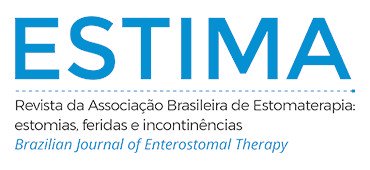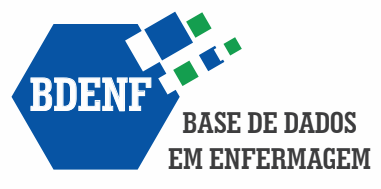LARVOTHERAPY IN THE TREATMENT OF DIFFICULT-TO-HEAL LESIONS: INTEGRATIVE REVIEW
Abstract
Objective: To analyze the evidence available in the literature about the use of larvotherapy in the treatment of difficult-to-heal wounds. Method: This is an integrative review, having as a guiding question: what evidence is available in the literature about the use of larvotherapy in the treatment of wounds that are difficult to heal? The inclusion criteria were: original articles, literature review and experience reports, from 2016 to 2021, available online in full, in Portuguese, English and Spanish and that answered the research question. Exclusion criteria were: duplicate articles, letters to the editor, dissertations, theses, monographies and research with animals. Searches took place at Virtual Health Library and United Station National Library of Medicine between August and September 2021. Results: Ten articles were selected. The main advantages were: selective debridement, bactericidal or bacteriostatic action, and promotion of granulation tissue and healing factors. The main disadvantages were: pain, discomfort, prejudice, and weaknesses with the larval production market. Conclusion: The advantages found outweigh the disadvantages evidenced. Therefore, larvotherapy is favorable to treat wounds that are difficult to heal.
Downloads
Metrics
References
Cavassan NRV, Camargo CC, Pontes LG, Barraviera B, Ferreira RS, Miot AM, et al. Correlation between chronic venous ulcer exudate proteins and clinical profile: A cross sectional study. J Proteomics 2019;192:280-90. https://doi.org/10.1016/j.jprot.2018.09.009
Borges EL, Nascimento Filho HM, Pires Júnior JF. Prevalência de lesões crônicas de município da zona da mata mineira (Brasil). Rev Min Enferm 2018;22:e-1143. http://www.dx.doi.org/10.5935/1415-2762.20180074
Silva PN, Almeida OAE, Rocha IC. Terapia tópica en el tratamiento de las heridas crónicas. Enferm Glob [Internet]. 2014 [acessado em 10 jun. 2021];13(33):33-45. Available at: https://revistas.um.es/eglobal/article/view/eglobal.13.1.165461/156721
Sams-Dodd J, Sams-Dodd F. Time to abandon antimicrobial approaches in wound healing: A paradigm shift. Wounds [Internet]. 2018 [acessado em 10 jun. 2021];30(11):345-52. Available at: https://www.hmpgloballearningnetwork.com/site/wounds/reviews/time-abandon-antimicrobial-approaches-wound-healing-paradigm-shift
Brasil. Ministério da Saúde. Agência Nacional de Vigilância Sanitária. Fundação Oswaldo Cruz. Anexo 02: Protocolo para prevenção de úlcera por pressão. Brasil: Ministério da Saúde; 2013.
Costa AM, Matozinhos ACS, Trigueiro PS, Cunha RCG, Moreira LR. Custos do tratamento de úlceras por pressão em unidade de cuidados prolongados em uma instituição hospitalar de Minas Gerais. Rev Enferm Rev [Internet]. 2015 [acessado em 10 jun. 2021];18(1):58-74. Available at: http://periodicos.pucminas.br/index.php/enfermagemrevista/article/view/9378/10327
Oliveira AP, Oliveira BGRB. Custo do tratamento de úlceras venosas no ambulatório e domicílio: estudo descritivo. Online Braz J Nurs [Internet]. 2015 [acessado em 10 jun. 2021];14(3):221-8. Available at: http://www.objnursing.uff.br/index.php/nursing/article/view/4842/html_674
Fonseca-Muñoz A, Sarmiento-Juménez HE, Pérez-Pacheco R, Thyssen PJ, Sherman RA. Clinical study of Maggot therapy for Fournier’s gangrene. Int Wound J 2020;17(6):1642-9. https://doi.org/10.1111/iwj.13444
Sherman RA, Hall MJR, Thomas S. Medical Maggots: an ancient remedy for some contemporary afflictions. Annu Rev Entomol 2000;45:55-81. https://doi.org/10.1146/annurev.ento.45.1.55
Tanyuksel M, Araz E, Dundar K, Uzun G, Gumus T, Alten B, et al. Maggot debridement therapy in the treatment of chronic wounds in a military hospital setup in Turkey. Dermatology 2005;210(2):115-8. https://doi.org/10.1159/000082566
Wollina U, Karte K, Herold C, Looks A. Biosurgery in wound healing – the renaissance of maggot therapy. J Eur Acad Dermatol Venereol 2000;14(4):285-9. https://doi.org/10.1046/j.1468-3083.2000.00105.x
Pinheiro MARQ, Ferraz JB, Junior MAA, Moura AD, Costa MESM, Costa FJMD, et al. Use of maggot therapy for treating a diabetic foot ulcer colonized by multidrug resistant bacteria in Brazil. Indian J Med Res 2015;141(3):340-2. https://doi.org/10.4103/0971-5916.156628
Gonçalves JR. Como escrever um artigo de revisão de literatura. Rev JRG Estudos Acadêmicos 2019;2(5):29-55. https://doi.org/10.5281/zenodo.4319105
Cooper HM. The integrative research review: a systematic approach. Beverly Hills: Sage; 1984.
Araújo WCO. Recuperação da informação em saúde: construção, modelos e estratégias. ConCl Conv Ciênc Inform 2020;3(2):100-34. https://doi.org/10.33467/conci.v3i2.13447
Trujillo OMH, Castrillón CA, Giraldo LX, Gutiérrez LM, Sepúlveda SB. De lo convencional a lo alternativo en el manejo de las úlceras venosas. Rev Urug Enferm [Internet]. 2016 [acessado em 2 out. 2021];11(2):89-100. Available at: http://rue.fenf.edu.uy/index.php/rue/article/view/201/196
Arabloo J, Grey S, Mobinizadeh M, Olyaeemanesh A, Hamouzadeh P, Khamisabadi K. Safety, effectiveness and economic aspects of maggot debridement therapy for wound healing. Med J Islam Repub Iran [Internet]. 2016 [acessado em 2 out. 2021];30:319. Available at: https://www.ncbi.nlm.nih.gov/pmc/articles/PMC4898856/
Blanco LJ. Tratamiento de úlceras en el pie diabético: revisión. Rev Int Cienc Podol. 2017;11(2):137-47. https://doi.org/10.5209/ RICP.56030
Raposio E, Bortolini S, Maistrello L, Grasso DA. Larval therapy for chronic cutaneous ulcers: historical review and future perspectives. Wounds [Internet]. 2017 [acessado em 5 out. 2021];29(12):367-73. Available at: https://www.hmpgloballearningnetwork.com/site/wounds/article/larval-therapy-chronic-cutaneous-ulcers-historical-review-and-future-perspectives
Stadler F. The maggot therapy supply chain: a review of the literature and practice. Med Veter Entomol 2020;34(1):1-9. https://doi.org/10.1111/mve.12397
Lipiński P, Trzciński R, Dziki L, Mik M. Phantom pain as an adverse effect after maggot (Lucilia sericata) debridement therapy:a case study. J Wound Care 2020;29(5):303-5. https://doi.org/10.12968/jowc.2020.29.5.303
Silva SM, Millions RM, Almeida RC, Costa JE. Terapia larval sob a ótica do paciente. ESTIMA, Braz J Enterostomal Ther 2020;18(1):e3020. https://doi.org/10.30886/estima.v18.963_PT
Nair HKR, Ahmad NW, Teh CH, Lee HL, Chong SSY. Maggot debridement therapy in malaysia. Int J Low Extrem Wounds 2021;20(3):208-16. https://doi.org/10.1177/1534734620932397
Greene E, Avsar P, Moore Z, Nugenti L, O’Connor T, Patton D. What is the effect of larval therapy on the debridement of venous leg ulcers? A systematic review. J Tissue Viability 2021;30(3):301-9. https://doi.org/10.1016/j.jtv.2021.05.005
Szczepanowski Z, Grabarek BO, Boro D, Tukiendorf A, Kulik-Parobczy I, Miszczyk L. Microbiological effects in patients with leg ulcers and diabetic foot treated with Lucilia sericata larvae. Int Wound J 2022;19(1):135-43. https://doi.org/10.1111/iwj.13605
Faura MDM, Romero MF, Martínez CO, Mallo MEG. Maggot therapy: case study in home care. Rev Enferm 2016;39(4):26-9.
Díaz-Roa A, Patarroyo MA, Bello FJ, Silva Junior PI. Sarconesin: sarconesiopsis magellanica blowfly larval excretions and secretions with antibacterial properties. Front Microbiol 2018 [citado 2021 nov 21];9:2249. https://doi.org/10.3389%2Ffmicb.2018.02249
Downloads
Published
How to Cite
Issue
Section
License
Copyright (c) 2022 Luane de Freitas Souza Lucio Ferreira , Rafaela Muniz Pinto de Figueiredo, Larissa da Silva Oliveira , Raphael Pessoa Custodio Vieira, Evelin Peixoto Braga Vieira Leal, Joana Dias Pereira, Alcione Matos de Abreu , Raquel de Almeida Ramos Figueiredo

This work is licensed under a Creative Commons Attribution 4.0 International License.

























